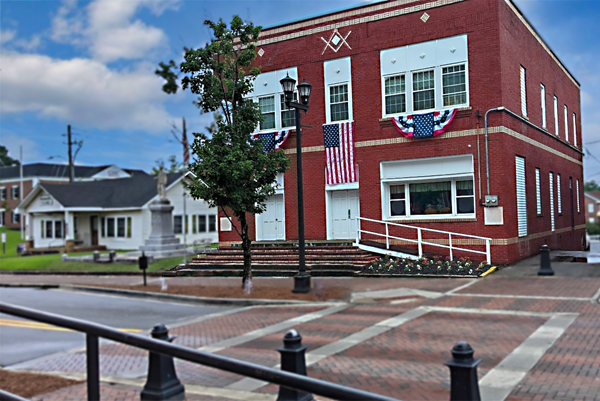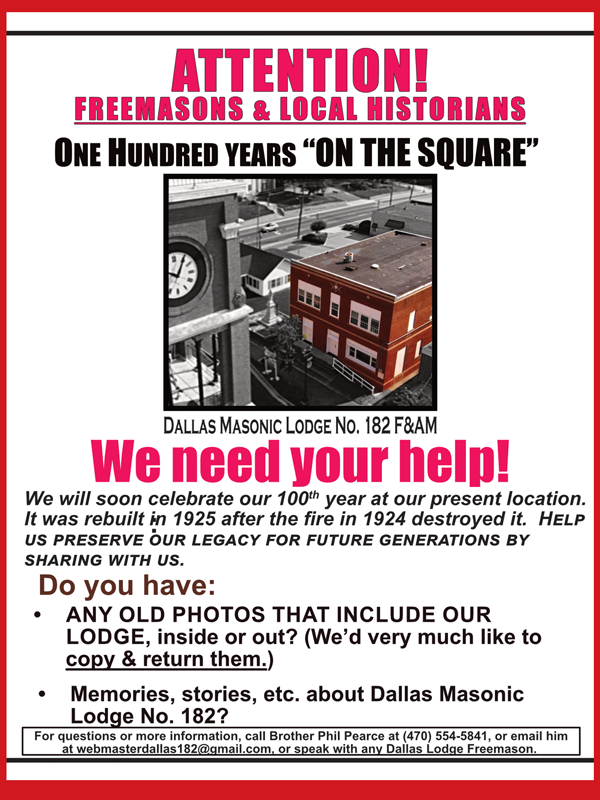 In the heart of Dallas, Georgia, where Main Street curves gently through time, one brick structure stood as a quiet witness to generations of public service, fellowship, and history. Built in 1853—the same year Dallas Masonic Lodge No. 182 F&AM received its charter and a year before the town was incorporated by the Georgia General Assembly—the two-story brick courthouse was among the town’s earliest landmarks. By 1892, however, the fast-growing county had outgrown it, and Paulding County constructed a new, larger courthouse (Building B) across the street. But the old structure (let’s call it Building A) found new life.
In the heart of Dallas, Georgia, where Main Street curves gently through time, one brick structure stood as a quiet witness to generations of public service, fellowship, and history. Built in 1853—the same year Dallas Masonic Lodge No. 182 F&AM received its charter and a year before the town was incorporated by the Georgia General Assembly—the two-story brick courthouse was among the town’s earliest landmarks. By 1892, however, the fast-growing county had outgrown it, and Paulding County constructed a new, larger courthouse (Building B) across the street. But the old structure (let’s call it Building A) found new life.
Dallas Lodge purchased the upper floor from the county, while the ground level housed professionals: attorneys, dentists, and others who made up the civic backbone of the growing town. For more than three decades, the building served dual purposes—fraternal and professional—until one fateful summer night in 1924, when flames erased it from the landscape.
A Fire in the Night
Late on the evening of July 26, 1924, a fire broke out in the old courthouse (Bldg. A). It came just hours after the Lodge had held its regular Saturday meeting. By dawn on the 27th, only portions of the brick walls still stood. The structure had been gutted. The mostly wooden interior was completely destroyed.
Contemporary news reports are frustratingly few, but what accounts remain paint a grim picture. Offices on the lower floor, including those of Dr. W. H. Hansard (a dentist) and attorney Col. A. J. Camp, were completely lost. No cause of the fire was ever determined, and no injuries were reported. Yet the material loss was heavy. Firefighting capabilities in smaller towns like Dallas were limited in those days, and by the time help arrived, it was too late. The flames had consumed nearly everything.
What Was Lost
For the community, the fire was a visible and painful loss—a 70-year-old landmark reduced to rubble overnight. But for the members of Dallas Masonic Lodge No. 182, the destruction struck even deeper.
The second floor had been their meeting hall since the 1890s, and inside were not just chairs and regalia, but the written memory of the Lodge itself: minute books, membership rolls, memorial resolutions, financial ledgers, and other documents tracing the Lodge’s life from 1853 onward. These were presumed lost in the blaze. The Lodge’s own written history, composed many years later, puts it plainly: “We must assume that all of the Lodge minutes were destroyed.” But maybe not.
Rebuilding and Remembering
Despite the devastation, the Lodge was determined to rebuild. Fundraisers were held, loans were secured, members dug deeply into sometimes meager savings, and an angel or two just might have been at work. The Lodge purchased the ground on which the old courthouse had stood, and in 1925, a new two-story structure (which we’ll call Building C) rose from the ashes—quite literally, as some of the bricks from the original structure were salvaged and reused. The Lodge once again met upstairs, and the ground floor was soon leased to the U.S. Post Office, which occupied the space into the 1940s. Later tenants included law offices, local businesses, and, briefly, a bicycle shop. In the 1950s, as the Lodge also grew, the downstairs was converted into a dining room, kitchen, and storage spaces.
Today, the Lodge still occupies that building on Main Street, continuing a tradition of service, brotherhood, and quiet stewardship. The records from 1925 onward have been carefully preserved and, in recent years, digitized. They will no longer be lost to fire, flood, or the ravages of time. They are forever safe. But that long, irreplaceable stretch from 1853 to 1924 remains largely blank. There is a void in the written memory of the Lodge and, indeed, the town.
A Look Back Brings Hope
For decades, it was accepted as fact that because of the fire all the Lodge’s minutes, from 1853 to 1924, were lost. But a curious letter written in 1978 offers a sliver of doubt, and perhaps a sliver of hope.
As the Lodge prepared to celebrate its 125th anniversary in 1978, the Lodge Secretary wrote to the Grand Lodge of Georgia asking for the names of members initiated from 1908 to 1924. He explained that this information had been lost in the 1924 fire. But to someone who read the letter much later, its wording raised a tantalizing question: if the Lodge specifically requested names from that period, did that mean records prior to 1908 still existed?
It might have been nothing—maybe just innocent phrasing. Or perhaps it was something more. In many lodges of the era, older record books were sometimes kept at an officer’s home or placed in safekeeping elsewhere. If even one of the earlier minute books escaped the fire—either by chance or foresight—it might still survive, quietly resting in a box or trunk, waiting to be discovered.
A Community’s Chance to Remember
And here lies the heart of the mystery. As the Lodge begins preparations for its 100th anniversary celebration of the 1925 cornerstone laying ceremony of the new lodge building, might someone in the Dallas area—perhaps a descendant of a Lodge officer, or a collector of local memorabilia—hold a forgotten photo, letter, or page of minutes from before the fire? Could there be, in a family album or attic box, a picture of the old building in flames, or of work beginning on its resurrection, or of the cornerstone ceremony?
To date, no such photographs or clippings have surfaced, save for a brief article in the Atlanta Constitution, with no photos, that appeared the day after the fire. No rescued pages of the minutes have come to light. But it’s not impossible. We know how quietly such things can pass through generations, stored away with little idea of their historical value.
The possibility is dwindling that some of the Lodge minutes may still exist. But Lodge members still hold out hope that someone, somewhere, may have a photo of the old courthouse from before 1924, or some documents related to Dallas Lodge, or even something as simple as a newspaper clipping about the fire. If so, we would be honored to see it. The Lodge does not wish to keep these items; we’d simply like to scan or copy them, and we’d be glad to coordinate that process in a way that ensures your materials are returned promptly and safely. If desired, a member of the Lodge can meet you at a local UPS Store or library, and you can observe the copying process yourself.
Sometimes, history is preserved not in libraries or museums, but in shoeboxes and scrapbooks. We’re hoping that some such treasure might yet be found. To learn more about the Lodge’s history or to contact us, visit dallasmasoniclodge182.org and click on the “History” tab.
by Phil Pearce


















